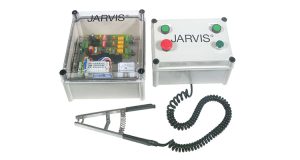
Electric Stimulation
The term ‘electric stimulation’ refers to all currents applied to the carcasses on the slaughter floor, and includes those applied for the following reasons:
- immobilisation of carcasses following stunning;
- additional blood release following sticking;
- carcase rigidity at the downward hide puller; and
- prevention of meat toughness .
In addition to their intended physical effect on the carcass, each of these electrical inputs may contribute to the pH decline in the muscles. Excessive electrical inputs may effectively over-stimulate carcass and cause a rapid pH decline with undesirable effects on meat-eating quality. Thus, when evaluating the overall effect of an electrical input, it must be considered in conjunction with all other electrical inputs being applied to the carcass.
Modern electro-immobilisation systems incorporate medium voltage, high frequency waveforms which provide a still carcase after the current is switched off. This enables shackling to take place while the hind legs are relaxed. The current may need to be applied for a period of 6 to 10 seconds before this state of relaxation is produced.
How Electrical stimulation (ES) Work
It is well documented that beef carcass that cool rapidly may have poor meat quality as a result of cold-induced shortening and toughening. The Tender stretch process prevents the shortening of many muscles of the carcass and thus produces meat of superior eating quality. Where there is a preference for the conventional Achilles tendon hung—rather than the Tender stretch hung—beef side, it may be necessary to apply an electrical current specifically to prevent cold induced toughness. This process is referred to as ‘electrical stimulation’ (ES) and, for many years, was often the only electrical input (other than hide-puller stiffening) applied to the carcass. ES is used less commonly now as the combined slaughter-floor electrical inputs generally provide adequate stimulation. If ES is required, it can be easily applied to the beef sides via rubbing bars, prior to their entry into the chiller. For low throughput beef-processing plants, with few other electrical inputs, there may still be a role for the ES to be applied to the body after stunning and sticking via manually inserted nostril and probes.
Ultimate pH
Electrical inputs accelerate the rate of pH decline and, therefore, will reduce the time for the ultimate pH to be reached. Carcasses that receive no electrical inputs and are chilled rapidly may take 24 or even 48 hours for the ultimate pH to be achieved; however, in commercial practice, most carcasses will be at, or very close to, their ultimate pH by 18 hours. Chiller assessment cannot be undertaken until the loin muscle has reached its ultimate pH.
Carcasses that have received several electrical inputs may reach their ultimate pH within a few hours of slaughter and, thus, can be assessed at an earlier time than would otherwise be permissible.
Meat colour
Until the ultimate pH is reached, the muscles of carcasses that have received electrical inputs are likely to be lighter in colour and have a brighter red colour than those from similar carcasses that have not received electrical inputs. Electrical inputs are likely to have a comparatively minor effect on the colour once the ultimate pH is reached, but over-stimulation may cause a paleness of the muscles.

